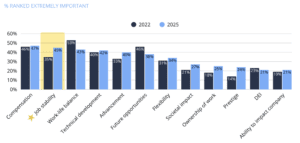October 16, 2025
5 Rules for Recruiting Early Career Tech Talent
The Early Career tech recruiting playbook has been rewritten. After years of volatility, including mass layoffs, AI disruption, and ongoing visa uncertainty, the market has stabilized on the surface but remains deeply complex beneath it. While technically an employer’s market, the fight for top technical talent has never felt tougher.
During our recent webinar, The New Rules of Recruiting Early-Career Tech Talent, our experts shared research from thousands of student surveys and hundreds of employer conversations to determine the five new rules shaping how tech talent is recruited today.
Rule #1: Win Talent by Knowing and Meeting Student Needs
In 2025, confidence, not cool perks, is the new currency. Work-life balance once topped student priorities, but in a post-layoff landscape, job stability now rivals compensation as the deciding factor for tech candidates. Students are asking, “Will this role still exist when I graduate?”
Employers win by signaling security and long-term investment. This can look like spotlighting retention rates, internship-to-full-time conversion rates, and leadership commitment to Early Career programs. Transparency around financial performance and headcount trends helps rebuild the trust shaken by years of industry turbulence.

The takeaway? Even in an employer’s market, you still have to sell yourself, especially your staying power.
Rule #2: Understand and Mitigate Your Poaching/Renege Risk
Renege rates among tech candidates have nearly doubled in the past two years. Students, wary of instability, often accept one offer while still searching for “safer” options. This results in lost time, lost budget, and a last-minute scramble to fill roles for University Recruiting teams.
The solution is to treat reneges as a strategic risk, not an administrative inconvenience. We see top employers:
- Set cutoff dates for reopening requisitions to save recruiter bandwidth
- Overhire based on historical acceptance rates
- Maintain “silver medalist” lists of near-hires and keep them warm
- Utilize structured keep-warm strategies through social touchpoints, mentorship pairings, and newsletters to sustain excitement through to the start date
Get strategies to mitigate reneges
Rule #3: Compete on Employer Brand, Not Just Industry Reputation
Students are no longer thinking in industry siloes. Tech talent is seriously considering finance, consulting, aerospace, and semiconductor industries just as much as they are considering Big Tech. That means Google isn’t your only competition. You are now also up against the likes of J.P. Morgan, Deloitte, and Lockheed Martin, too.
Our Talent Rank data reveals exactly how students evaluate and rate top employers. Tech companies dominate awareness and desirability, but finance firms score higher on perceived job security. The smartest recruiting teams are using this insight to position their brand advantage. For example, they emphasize stability and structured growth to counter the narrative around Big Tech’s volatility.
Whether you’re a global giant or a niche innovator, brand differentiation–not industry prestige–determines who wins over talent’s intent to apply.
Rule #4: Adapt Your Talent Strategy for the Age of AI
The headlines warn that AI is simultaneously erasing and creating Early Career roles. Entry-level coding and QA tasks (the traditional training ground for new engineers) are increasingly automated, and junior tech employment has fallen by ~6% since late 2022. Meanwhile, demand surges for applied and foundational AI talent.
Recruiting teams must rethink both what they’re hiring for and how they evaluate candidates in an AI-infused world. That means:
- Mapping which roles are augmented vs automated by AI
- Building new assessments that test applied problem-solving, not rote tasks
- Guarding against AI-enabled candidate fraud in applications and technical screenings
Rule #5: Respond Proactively to Visa Shifts
The H-1B landscape is shifting faster than most teams are able to adapt. New proposals, like a four-year gap on student visas and a $100,000 H-1B fee, are reshaping the Early Career talent pipeline. The impact is significant and far-reaching, as more than half of U.S. tech master’s students and two-thirds of AI PhDs are international.
Employers are responding in three ways:
- Staying the course for hard-to-fill specialized roles, justifying sponsorship on a case-by-case basis
- Pulling back temporarily to reduce uncertainty and cost
- Relocating or near-shoring roles to offices in Canada or Mexico
Proactive planning, identifying critical sponsored roles, modeling global contingencies, and maintaining transparency with candidates will keep your pipeline more resilient amid policy turbulence.
The Bottom Line
Recruiting Early Career tech talent today requires balancing data, empathy, and agility. The market is fierce, but the employers winning it are those who:
- Communicate stability,
- Protect hard-won offers,
- Sharpen their brand positioning,
- Modernize for AI, and
- Plan ahead for global mobility shifts
In this era, success is not anchored to having the loudest brand, but the most trusted one.
